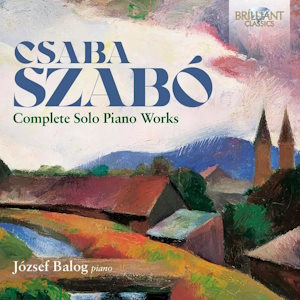
Csaba Szabó (1936–2003)
Complete solo piano works
József Balog (piano)
rec. 2022, Budapest, Hungary
Brilliant Classics 97104 [50]
Hungarian composer and musicologist Csaba Szabó was born in Transylvania in what is today’s Romania. He came under the influence of Zoltán Kodály, having studied under two of Kodály’s host of students, János Jagamas and Gábor Jodál. Franz Schmidt may also have been an influence through the tuition Szabó received from one of Schmidt’s students, József Trózner. In fact there’s precious little of Schmidt in these pieces. Much of Szabó’s career was forged in Hungarian music institutions. He also immersed himself in, and became an authority on, local folk music. After his death a Society in Szabó’s name promoted and continues to promote his music. This accounts for a Hungaroton CD of Szabó’s chamber music.
While we are pretty much starved of recordings of Szabó’s music – try a search – his catalogue offers pages of potential stimulation. There are orchestral and vocal/choral-orchestral works, chamber music, songs, choral pieces, staged works, incidental musical for theatre and solos.
The first three works here (Baroque rondo; Vivace e trio and Theme and Five Variations) track their way from an innocently trickling Mozartean innocence to Beethovenian moonlight. Then, in the Theme and Five Variations, doors open onto playful fountains of Meissen-like delicacy and quasi-military fast-flowing baroque rondos.
The world turns towards a cloud-occluded landscape for the next pieces. The Scherzando definitely marks a chromatic break and a crashing of gears with its Bartókian complexity. The Bagatel is of the same brethren with it cut-glass farmyard dreamscapes. The Little Suite is in four movements. Cue a nursery rhyme world, but one with a knowing undercurrent and a weakness for torrential virtuosity. The finale, which is a ‘Toccatino Ungharese’, perhaps reflects the influence of Rózsa. The Four Miniatures are at times chaste, with the movement in Homage to Mozart sounding nothing like the Salzburg composer – and why should it? It’s a homage – and a subtle and somewhat minatory one – not a pastiche. The Suite ends in full flood: whirling and turning, as does the next piece (Dance with Fate): again a festival of torrents and clashes. This “style chapter” ends with Parlando, giusto e corale with its insistent tolling. It’s a commanding piece from 1973 and runs to over nine minutes.
In his later years, Szabó found himself compelled to fling caution aside in favour of savage invention. The prepared piano was now the preferred medium of expression. Roaming Tune (When I Started from Csík) is a wild fantasy with rubber band sounds; sounds that not so much twang as resound bluntly. Other aspects of the piece suggest an Ultima Thule frequented at the same time by both Ariel and Caliban. Yes, an isle “full of noises” but in this case less of the “Sounds and sweet airs, that give delight and hurt not”.
Still in this state, Szabó wrote Moving Away in 1981 for Bartók’s 100th anniversary. This theme and eight variations is founded on the first part of Bartók’s Three Folk Tunes From Csik County. The journey charts its way from lovingly spun pianism. It arrives at some equally lovingly-executed rattling and clatter. Thus, the prepared piano (with paper between the strings) and the pianist’s humming. Zither-like sounds, insect buzzing and chittering, dissonance and wooden clatter are all to be heard. For all its seeming experimentation it emerges as most inventive and engages mind and ear and heart.
Hungarian pianist József Balog communicates Szabó’s contribution, which continues through music that is in three style-phases. These are first recordings. By the way, Balog has also recorded the piano works of László Lajtha and Zoltán Kodály.
The English language booklet sketches in the details, courtesy of music writer Enikő Gyenge.
A scarcely known Hungarian composer is permitted an eloquent and at times disconcerting calling-card.
Rob Barnett
Help us financially by purchasing from



Contents
1 Baroque rondo
2 Vivace e trio
3-8 Theme and Five Variations
9 Scherzando
10 Bagatel, the Last Scenes of Carnival
11-14 Little Suite
15-18 Four Miniatures
19 Dance with Fate
20 Parlando, giusto e corale
21 Roaming Tune (When I Started from Csík)
22-30 Moving Away: Theme and Eight Variations

















